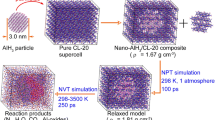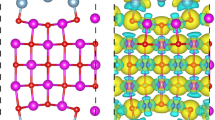Abstract
1,1-Diamino-2,2-dinitroethylene (FOX-7) is well-known as one high-energy insensitive material. The size effect of the nano-crystal on the pyrolysis are extremely important for ignition and reaction pathways under extreme conditions. The thermal decomposition of nano-FOX-7 was investigated utilizing molecular dynamics method with reactive force field. The pyrolysis simulation showed that the potential barrier of nano-FOX-7 at 3000 K are higher than that at 2000 K. The temperature distribution of nano-FOX-7 in the temperature-rise periods shows that the decomposition occurs first at the central part of the crystal. Based on the analysis of chemical species, three types of initial reaction pathways were identified, among which the fission of the C–NH2 bond may be a new reaction pathway. A decomposition network from initial reactant to the main products was proposed to provide insights into the decomposition mechanism on atomic level. The mass distribution of products showed that the clusters among the decomposition products can inhibit the violent reaction to a certain extent. In addition, the analysis of the nano-crystal effect on the FOX-7 decay shows that the numbers of N2 and CO2 are related to the nanoparticle size.
Graphical abstract











Similar content being viewed by others
References
R. Bu, H. Li, C. Zhang, Polymorphic transition in traditional energetic materials: influencing factors and effects on structure, property and performance. Cryst. Growth Des. 20, 3561–3576 (2020)
R. Bu, W. Xie, C. Zhang, Heat-induced polymorphic transformation facilitating the low impact sensitivity of 2,2-dinitroethylene-1,1-diamine (FOX-7). J. Phys. Chem. C 123, 16014–16022 (2019)
V.W. Manner, M. Cawkwell, E.M. Kober et al., Examining the chemical and structural properties that influence the sensitivity of energetic nitrate esters. Chem. Sci. 9, 3649–3663 (2018)
H.Y. Lee, M.J. Kim, W. Bokjeong et al., Habit modification of 1,1-diamino-2,2-dinitroethylene (DADNE) by crystallization. Sci. Technol. Energ. Mater. 73, 59–62 (2012)
H.M. Shim, H.S. Kim, K.K. Koo, Molecular modeling on supersaturation-dependent growth habit of 1,1-diamino-2,2-dinitroethylene. Cryst. Growth Des. 15, 1833–1842 (2015)
W. Zhang, L. Bao, K. Jiang et al., Identification and formation mechanism of the transient ion fragments produced in laser-induced dissociation of 1,1-diamino-2,2-dinitroethylene. Laser Part Beams 36, 308–312 (2018)
V.I. Pepekin, B.L. Korsunskii, A.A. Denisaev, Induction of the explosion of solid explosives under mechanical action. Fiz. Goreniya Vzryva 44, 101–105 (2008)
W.A. Trzcinski, Z. Chylek, S. Cudzilo et al., Investigation of detonation characteristics and sensitivity of FOX-7-based phlegmatized explosives. Biul. Wojsk. Akad. Tech. 57, 7–25 (2008)
X. Li, X. Zhang, W. Yang et al., Design and characterization of a cook-off resistant high-energy booster explosive based on CL-20/FOX-7. Propellant Explos. Pyrotech. 44, 550–556 (2019)
M.K. Shukla, J. Wang, J. Seiter et al., Understanding the fate of insensitive munitions compounds: computational study on adsorption of nitroguanidine (NQ) and 1,1-diamino-2,2-dinitroethylene (FOX7) on pristine and Al-hydroxylated α-alumina surfaces. J. Phys. Chem. C 121, 11560–11567 (2017)
N.V. Latypov, J. Bergman, A. Langlet et al., Synthesis and reactions of 1,1-diamino-2,2-dinitroethylene. Tetrahedron 54, 11525–11536 (1998)
F.J. Zerilli, M.M. Kuklja, First principles calculation of the mechanical compression of two organic molecular crystals. J. Phys. Chem. A 110, 5173–5179 (2006)
K. Wang, J.-G. Chen, Z.-B. Nie et al., Impact of the acidic group on the hydrolysis of 2-dinitromethylene-5,5-dinitropyrimidine-4,6-dione. RSC Adv. 8, 13301–13309 (2018)
A. Saikia, R. Sivabalan, G.M. Gore et al., Synthesis of some potential high energy materials using metal nitrates; an approach towards environmental benign process. J. Sci. Ind. Res. India 73, 485–488 (2014)
L. Liu, H. Li, D. Chen et al., Solubility of 1,1-diamino-2,2-dinitroethylene in different pure solvents and binary mixtures (dimethyl sulfoxide + water) and (N,N-dimethylformamide + water) at different temperatures. Fluid Phase Equilib. 460, 95–104 (2017)
T. Li, R. Li, F. Nie et al., Facile preparation of self-sensitized FOX-7 with uniform pores by heat treatment. Propellant Explos. Pyrotech. 39, 260–266 (2014)
H.-X. Gao, F.-Q. Zhao, R.-Z. Hu et al., Thermochemical properties, thermal behavior and decomposition mechanism of 1,1-diamino-2,2-dinitroethylene (DADE). Chin. J. Chem. 24, 177–181 (2006)
Y. Liu, F. Li, H. Sun, Thermal decomposition of FOX-7 studied by ab initio molecular dynamics simulations. Theor. Chem. Acc. 133, 165–175 (2015)
R. Xu, C. An, H. Huang et al., Preparation of multi-scale FOX-7 particles and investigation of sensitivity and thermal stability. RSC Adv. 9, 21042–21049 (2019)
L. Jiang, X. Fu, Z. Zhou et al., Study of the thermal decomposition mechanism of FOX-7 by molecular dynamics simulation and online photoionization mass spectrometry. RSC Adv. 10, 21147–21157 (2020)
T. Vladimiroff, B.M. Rice, Reinvestigation of the gas-phase structure of RDX using density functional theory predictions of electron-scattering intensities. J. Phys. Chem. A 106, 10437–10443 (2002)
B.M. Rice, C.F. Chabalowski, Ab initio and nonlocal density functional study of 1,3,5-trinitro-s-triazine (RDX) conformers. J. Phys. Chem. A 101, 8720–8726 (1998)
L. Patidar, S.T. Thynell, Quantum mechanics investigation of initial reaction pathways and early ring-opening reactions in thermal decomposition of liquid-phase RDX. Combust. Flame 178, 7–20 (2017)
K. Chenoweth, A.C.T.V. Duin, P. Persson et al., Development and application of a ReaxFF reactive force field for oxidative dehydrogenation on vanadium oxide catalysts. J. Phys. Chem. A 112, 14645–14654 (2008)
S.C. Chowdhury, J.W. Gillespie, Silica–silane coupling agent interphase properties using molecular dynamics simulations. J. Mater. Sci. 52, 12981–12998 (2017)
Y. Sun, Q. Wang, Y. Wu et al., Numerical simulation of the combustion of nano-aluminum in carbon dioxide. Acta Astronaut. 139, 428–434 (2017)
Y. Yang, S.A. Peddakotla, R. Kumar et al., Effect of argon gas in oxygen catalytic recombination on a silica surface: a reactive molecular dynamics study. Acta Astronaut. 175, 5–6 (2020)
N.N. Smirnov, V.B. Betelin, V.F. Nikitin, L.I. Stamov et al., Accumulation of errors in numerical simulations of chemically reacting gas dynamics. Acta Astronaut. 117, 338–355 (2015)
K. Zheng, Y. Wen, B. Huang et al., The solid phase thermal decomposition and nanocrystal effect of hexahydro-1,3,5-trinitro-1,3,5-triazine (RDX) via ReaxFF large-scale molecular dynamics simulation. Phys. Chem. Chem. Phys. 21, 17240–17252 (2019)
T. Zhou, J. Lou, Y. Zhang et al., Hot spot formation and chemical reaction initiation in shocked HMX crystals with nanovoids: a large-scale reactive molecular dynamics study. Phys. Chem. Chem. Phys. 18, 17627–17645 (2016)
J. Li, S. Jin, G. Lan et al., Reactive molecular dynamics simulations on the thermal decompositions and oxidations of TKX-50 and twinned TKX-50. CrystEngComm 22, 2593–2600 (2020)
L. Liu, Y. Liu, S.V. Zybin et al., ReaxFF-lg: correction of the ReaxFF reactive force field for London dispersion, with applications to the equations of state for energetic materials. J. Phys. Chem. A 115, 11016–11022 (2011)
J.F. Moxnes, T.L. Jensen, E. Unneberg, Study of thermal instability of HMX crystalline polymorphs with and without molecular vacancies using reactive force field molecular dynamics. Adv. Stud. Theor. Phys. 10, 331–349 (2016)
Y. Wen, X. Xue, X. Long et al., Cluster evolution at early stages of 1,3,5-triamino-2,4,6-trinitrobenzene under various heating conditions: a molecular reactive force field study. J. Phys. Chem. A 120, 3929–3937 (2016)
X. Xue, Y. Wen, X. Long et al., Influence of dislocations on the shock sensitivity of RDX: molecular dynamics simulations by reactive force field. J. Phys. Chem. C 119, 13735–13742 (2015)
L. Chen, H. Wang, F. Wang et al., Thermal decomposition mechanism of 2,2′,4,4′,6,6′-hexanitrostilbene by ReaxFF reactive molecular dynamics simulations. J. Phys. Chem. C 122, 19309–19318 (2018)
B.M. Rice, J.P. Larentzos, E.F.C. Byrd et al., Parameterizing complex reactive force fields using multiple objective evolutionary strategies (MOES): part 2: transferability of ReaxFF models to C–H–N–O energetic materials. J. Chem. Theory Comput. 11, 392–405 (2015)
U. Bemm, H. Östmark, 1,1-diamino-2,2-dinitroethylene: a novel energetic material with infinite layers in two dimensions. Acta Crystallogr. C 54, 1997–1999 (1998)
Z. Mei, C.F. Li, F.Q. Zhao et al., Reactive molecular dynamics simulation of thermal decomposition for nano-AlH3/TNT and nano-AlH3/CL-20 composites. J. Mater. Sci. 54, 7016–7027 (2019)
L. Song, F.-Q. Zhao, S.-Y. Xu et al., Reactive molecular dynamics simulation of the high-temperature pyrolysis of 2,2′,2′′,4,4′,4′′,6,6′,6′′-nonanitro-1,1′:3′,1′′-terphenyl (NONA). RSC Adv. 10, 5507–5515 (2020)
Z. Ke, W. Yushi, H. Bing et al., The solid phase thermal decomposition and nanocrystal effect of hexahydro-1,3,5-trinitro-1,3,5-triazine (RDX) via ReaxFF large-scale molecular dynamics simulation. Phys. Chem. Chem. Phys. 21, 17240–17252 (2019)
F. Wang, L. Chen, D. Geng et al., Effect of density on the thermal decomposition mechanism of epsilon-CL-20: a ReaxFF reactive molecular dynamics simulation study. Phys. Chem. Chem. Phys. 20, 22600–22609 (2018)
F. Wang, L. Chen, D. Geng et al., Thermal decomposition mechanism of CL-20 at different temperatures by ReaxFF reactive molecular dynamics simulations. J. Phys. Chem. A 122, 3971–3979 (2018)
C. Deng, X. Xue, Y. Chi et al., Nature of the enhanced self-heating ability of imperfect energetic crystals relative to perfect ones. J. Phys. Chem. C 121, 12101–12109 (2017)
L. Yang, J. Wu, D. Geng et al., Reactive molecular dynamics simulation of the thermal decomposition mechanisms of 4,10-dinitro-2,6,8,12-tetraoxa-4,10-diazatetracyclo[5.5.0.05,9.03,11]dodecane’(TEX). Combust. Flame 202, 303–317 (2019)
Y. Wen, X. Xue, X. Long, C. Zhang, Cluster evolution at early stages of 1,3,5-triamino-2,4,6-trinitrobenzene under various heating conditions: a molecular reactive force field study. J. Phys. Chem. A 120, 3929–3937 (2016)
A. Strachan, E.M. Kober, A.C. van Duin, Thermal decomposition of RDX from reactive molecular dynamics. J. Chem. Phys. 122, 54502 (2005)
R. Cohen, Y. Zeiri, E. Wurzberg et al., Mechanism of thermal unimolecular decomposition of TNT (2,4,6-trinitrotoluene): a DFT study. J. Phys. Chem. A 111, 11074–11083 (2007)
M.T. Nguyen, H.T. Le, B. Hajgató et al., Nitromethane-methyl nitrite rearrangement: a persistent discrepancy between theory and experiment. J. Phys. Chem. A 93, 4286–4291 (2003)
Acknowledgements
This work is supported by the Fundamental Research Funds for the Central Universities.
Author information
Authors and Affiliations
Corresponding author
Ethics declarations
Conflict of interest
We declare that we do not have any commercial or associative interest that represents a conflict of interest in connection with the work submitted.
Additional information
Publisher's Note
Springer Nature remains neutral with regard to jurisdictional claims in published maps and institutional affiliations.
Supplementary Information
Below is the link to the electronic supplementary material.
Rights and permissions
About this article
Cite this article
She, C., Jin, S., Chen, S. et al. Reactive molecular dynamics simulation of thermal decomposition for nano-FOX-7. Appl. Phys. A 127, 881 (2021). https://doi.org/10.1007/s00339-021-05018-2
Received:
Accepted:
Published:
DOI: https://doi.org/10.1007/s00339-021-05018-2




